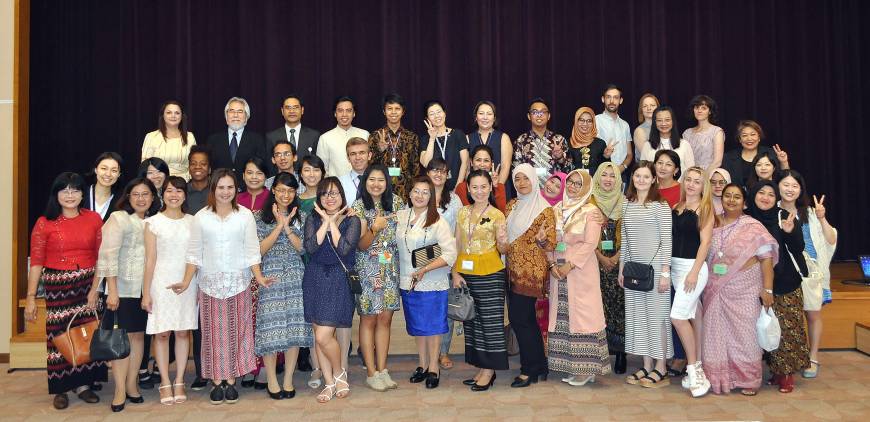

 2017 Short-Term Teacher Training Program Participant
2017 Short-Term Teacher Training Program ParticipantWestern Washington University
Bellingham, WA
Nihongojin is a neologism that refers to a group of people not categorized by race, ethnicity, or national citizenship, but rather as their ability to speak, read, write, and understand Japanese: “Japanese language people.” It is an exciting term that breaks down barriers of nation states to forefront inclusivity. The term implicitly acknowledges a complexly diverse global language community. Whether one lives in Poland, Uzbekistan, Russia, Argentina, Singapore, or the United States, regardless of embodied heritage, the Nihongojin identity asserts that the Japanese language community is much larger than an island or archipelago; it is the language of a global community that transcends both the body and political borders. Nihongojin are a people and a body of difference.
I encountered this word for the first time this summer at a workshop held at the Japan Foundation’s Japanese Language Institute in Urawa, Saitama. Thanks to the generous support of the Foundation, I participated in the Summer Short-Term Language Teacher Training Program from late June to late August. The program is designed for non-native speaking teachers of Japanese with three explicit goals in mind: 1) to engage in intensive language brush up; 2) to improve established language pedagogy practices; and 3) to experience first-hand cultural activities that can be brought back to classrooms overseas. These are the stated goals of the program, but there is a fourth benefit that is of equal, of not greater, importance. As one of only four native English speakers, I spent each day, all day, in Japanese, working with, building friendships, and learning discursively from 45 other participants from 21 countries—all non-native teachers of Japanese and all nihongojin. I experienced the vitality and transformative potential of this term first hand; it’s not often that Japanese is the defacto lingua franca, but for eight weeks of my summer I shared living, eating, and working space with strangers cum friends from the mountain reaches of Nepal to the beaches of Jamaica, and we did it all in Japanese.

Along with my fellow nihongojin, we soon came to appreciate the pedagogical and practical importance of namakyōzai (“raw” aka “primary source” materials), another term many of us encountered for the first time at the Institute. Over the course of the program, several workshops and activities encouraged us to seek out namakyōzai for use in developing practical classroom exercises in an attempt to expand effective pedagogical practices beyond the less effective and outdated techniques of textbook ondoku (reading aloud) and rote repetition that are at odds with contemporary communicative practices. Within my own cohort, determined by language aptitude established via placement test, I grew quite close to other PhDs and college-level teachers from Hungary, Poland, and Taiwan. Together, we ventured beyond the Institute and into the streets of local Saitama and further afield to Tokyo in search of namakyōzai to bring back home, the shipping of which was also generously paid for by the Foundation. My Taiwanese and Polish colleagues, specially trained and experienced in kanji acquisition, brought back invaluable examples of kanban (sign or notification) culture which we used collectively to re-theorize effective and meaningful techniques of kanji instruction and acquisition. My Hungarian colleague and I tackled the genre of annaisho (travel guides) in order to design a two-week classroom unit dedicated to planning travel itineraries using primary source materials to be implemented into advanced high school or intermediate college curriculums. We also canvassed the deliciously rich world of Japanese cuisine, harvesting actual menus and food packages to bring back to classrooms to use in real-world restaurant and shopping exercises.
As we incorporated into our syllabi these raw examples of language use experienced in Japan, as actualized nihongojin we soon began to understand that namakyōzai are not limited to language artifacts arising from and out of Japan itself, be it on the streets or on the Internet. Rather, as a global community of nihongojin, we are also creators of language production and namakyōzai every day, and potentially in every classroom experience. Our own language and communication isnamakyōzai.The materials we and our students create, especially those we cultivate communally across borders through online and in-person exchanges (blogs, texts, comment boards, study abroad programs, language circles, creative self-expression projects, etc.), are equally valid and viable examples of living language, the shared communicative expressions of nihongojin. As such, the participants of the program found exciting potential in not just collected examples of language experience in Japan, but also in shared expression outside of Japan, both physically on our respective campuses around the world as well as virtually on the ultimately unbounded Internet. As nihongojin, we explored the radical space of our own classrooms and international communities as the potential future of cross-cultural Japanese language communication. Most importantly, in these increasingly contentious times, as members of an incredibly rich and diverse international community, we learned that we can find common ground and space for new growth through our shared Japanese language as members of a global nihongojin identity.